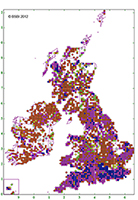The Early Purple-orchid is one of the earliest flowering orchids in Britain & Ireland and its appearance heralds a new orchid season. It is widely distributed and occurs in both woodland and in more open unimproved grassland habitats, including roadsides. In woodland it favours the edges and areas of recent coppice, where there is more abundant light. It is slow to colonise new areas and is regarded as a good indicator of ancient woodland. The flowering period extends from early April into June, varying with the timing of the season. The vegetative rosettes appear early in winter and in some areas they can be a target for browsing deer. In general, the leaves are heavily spotted but occasional plants do occur without the characteristic marking. As its common name suggests, the flowers are usually a shade of purple but pink and white flowers are present in many populations.
| Distribution Map | Key Features | |
 |
Records for the Early-purple Orchid from BSBI are shown on the map with most recent in front. (Hover the mouse over the small map to expand it.) |
Plant: 10-40cm occasionally 50-60cm, stem flushed purple towards the top |
Image Gallery for Early-purple Orchid Orchis mascula
| Pollination | Taxonomy & Hybrids |
The Early-purple Orchid is allogamous, depending on insect visitors for pollination. It is a deceit orchid that attracts insect visitors without offering a reward and does not produce nectar. The most widely accepted view is that the main pollinators are various species of bumblebee and the flowers are especially attractive to naive queens early in their flight period. The efficiency of seed set varies for different populations, probably in relation to the amount of insect activity. |
The Early-purple Orchid belongs to the subgenus Masculaeand it is defined as the subspecies Orchis mascula ssp. mascula. |
Articles about Early-purple Orchid in JHOS
Mike Gasson (2013) Pollination in the Early-purple Orchid. JHOS 10: 60-66
